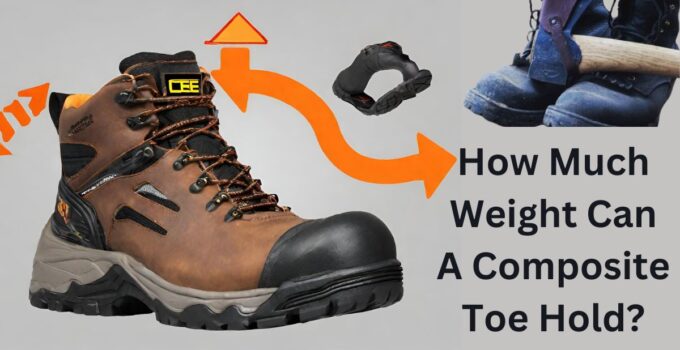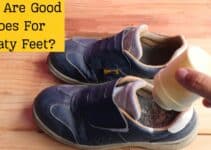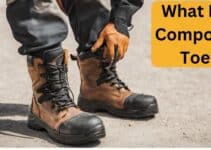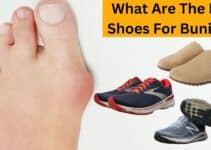Ever wondered: How much weight can a composite toe hold? Lifting heavy objects? Working in construction or a demanding job? Safety footwear with a composite toe is a must have. But can it handle the weight?
This guide dives deep into the weight capacity of composite toes, helping you choose the perfect work boots for ultimate foot protection. Keep your toes safe and your work on track. Read on!
How Much Weight Can A Composite Toe Hold?
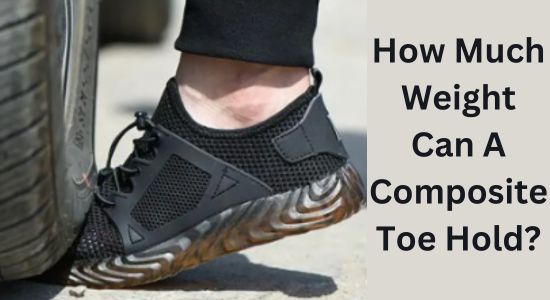
So, you are curious about how much weight a composite toe can handle. Those composite toe caps you find in safety shoes and boots? They are built tough to take a beating. It depends on several factors, including the materials used to make them, their design, and how much weight they can support. But they are sturdy, almost like their steel counterparts.
Typically, you can expect a composite toe cap to handle around 50 to 75 pounds of pressure without giving out. These can vary depending on the manufacturer and if certain safety standards are met. Safety always comes first, so ensure your footwear meets the necessary standards.
Factors Influencing Weight Capacity
Regarding composite toe caps’ weight-bearing capabilities, understanding the key factors is essential for making informed decisions about safety footwear. Let’s dive into these factors.
1- Material Composition
Composite toe caps are made from rigid materials like reinforced polymers and carbon fibers. These components team up to give the toe cap the strength it needs to handle different levels of pressure and impact. So, when wearing shoes with composite toe caps, you can trust that they have your toes covered, whether on the job or out and about.
2- Design and Construction
How composite toe caps are designed and built plays a big role in how much weight they can handle. Think about it like the architecture of a building: structural integrity, shape, and reinforcement techniques all contribute to the overall strength. Examining these design elements helps us understand the weight limits for different types of footwear.
3- Industry Standards
Meeting industry standards and regulations is crucial for ensuring the safety of composite toe footwear. These standards involve rigorous testing procedures that evaluate how much weight the safety footwear can bear. Knowing these standards helps us gauge how reliable and effective composite toe caps are in real-world situations.
Understanding Weight Limits
Now that we have covered the basics let’s get to the point. Understanding weight limits involves knowing manufacturer specifications, testing processes, and the importance of staying within those limits for your safety.
1- Manufacturer Specifications
Manufacturers provide detailed specs for composite toe footwear, including weight limits and performance expectations. Think of it as a user manual for your safety shoes. It’s a valuable reference that gives insights into what your footwear can handle in different situations.
2- Testing and Certification Processes
Safety footwear goes through strict testing to make sure it meets industry standards. Knowing about these tests gives us confidence in composite toe caps’ weight-bearing capabilities. Certifications from recognized testing organizations add an extra assurance that the footwear suits specific work environments.
3- Importance of Adhering to Weight Limits
Sticking to the weight limits set by manufacturers is crucial. It’s like following the recommended speed limit on the road. It ensures your composite toenail’s integrity and protective qualities. Going beyond these limits can compromise safety features, putting you at a higher risk of injury.
Practical Considerations
Let’s shift our focus to the practical side of things. Assessing your weight requirements, matching footwear to activities, and considering long-term durability are critical to optimizing performance and extending the lifespan of your safety footwear.
1- Assessing Individual Weight Requirements
We have unique weight requirements based on our body mass, job nature, and specific demands. By figuring out your weight needs, you ensure your composite toe footwear is tailored to keep you comfortable and safe during those long work hours.
2- Matching Footwear to Specific Activities
Different activities put varying stress on your safety footwear. It’s like choosing the right tool for the job. Matching your footwear to specific activities involves understanding the demands of your career and selecting composite toe caps with suitable weight capacities. This proactive approach enhances your comfort and extends the overall lifespan of your safety footwear.
3- Long-Term Durability and Weight Considerations
Thinking long-term is essential. How often you use your composite toe footwear, your work environment, and sticking to weight limits all impact durability. Prioritize weight considerations alongside durability to ensure your safety footwear provides sustained protection over time.
This concise and friendly overview maintains a conversational tone while covering the essential points.
Safety Implications
Discuss safety implications because it’s all about keeping you safe and sound. Exceeding weight limits can lead to severe consequences, affecting your foot health and overall safety. Let’s explore these implications a bit further.
1- Risks of Exceeding Weight Limits
Picture this: you’re pushing your composite toe caps beyond their specified weight limits. What happens? You might experience decreased impact resistance, compromised structural integrity, and an increased likelihood of injury. It’s like stretching a rubber band too far, and it snaps. Being aware of these risks is critical to making conscious decisions that prioritize your safety in the workplace.
2- Impact on Foot Health and Overall Safety
The weight bearing capacity of your composite toe footwear directly influences your foot health and, consequently, your overall safety. Ignoring weight limits can lead to discomfort, fatigue, and potential injuries. It’s like wearing shoes that don’t fit. You wouldn’t do that, right? Recognizing the impact on foot health emphasizes choosing safe footwear that aligns with your weight requirements.
3- Compliance with Workplace Regulations
Workplaces often have specific regulations, including weight limits for composite toes. Think of these regulations as guardrails on a highway. They are there to keep everyone safe. Complying with these rules is more than just a legal requirement. It is a fundamental aspect of creating a secure working environment. Make sure you’re familiar with your workplace guidelines to ensure you’re using your safety footwear properly.
Maintenance and Care
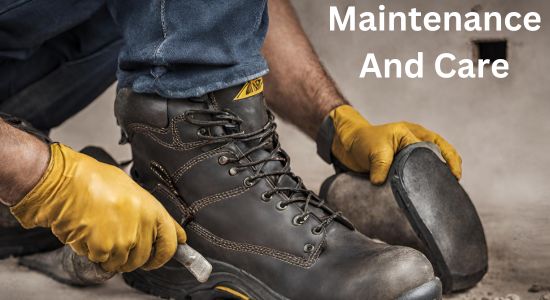
Now that we’ve covered safety, let’s shift gears to maintenance and care. Like any tool, your composite toe footwear needs some TLC to perform at its best. Let’s explore how you can keep your safety footwear in top-notch condition.
1- Inspecting Composite Toe Regularly
Think of your composite toe caps as your bodyguards. Regular inspections are like giving them a once-over to ensure they’re ready for action. A visual check, paying attention to the condition of the toe cap and surrounding materials, can help you identify any signs of wear, damage, or structural issues. Spotting issues early allows for timely maintenance and replacement. Consider it a health check for your safety shoes.
2- Cleaning and Preserving Structural Integrity
Cleaning your safety footwear isn’t just about aesthetics. It’s about preserving its structural integrity. Imagine your shoes are superheroes, and dirt and debris are their arch-nemeses. Regular cleaning and appropriate maintenance routines contribute to the longevity and effectiveness of your safety footwear. It’s like giving your shoes a spa day to ensure they’re ready for the next mission.
3- Extending the Lifespan of Composite Toe Footwear
Let’s talk about extending the lifespan of your trusty composite toe footwear. It’s not just a pair of shoes. It’s an investment in your safety. Store your footwear in a dry and well-ventilated environment, and think of it as a cozy home for your safety heroes. Avoid exposing them to harsh chemicals, and follow the manufacturer’s care instructions like you would a recipe. By prioritizing maintenance, you’re not just prolonging the lifespan of your safety footwear. You are ensuring they’re always there to have your back.
User Experiences and Recommendations
Now, let’s tap into the real-world experiences and valuable tips shared by others who’ve walked in your safety shoes. Hearing from fellow users and industry professionals adds a layer of authenticity to the information. It’s like getting advice from a trusted colleague or a seasoned pro.
1- Reviews of Weight Bearing Experiences
Imagine sitting with your work buddies and sharing stories about your composite toe footwear. User reviews offer precisely that: a chance to hear firsthand accounts from individuals who’ve been in various work environments. These reviews provide insights into different models’ weight-bearing capabilities, showcasing strengths and potential limitations. Considering a range of reviews helps you make informed decisions based on practical experiences, much like getting advice from your work crew.
2- Tips for Maximizing Composite Toe Performance
Let’s discuss the pros and tips for getting the most out of your composite toe footwear. Industry professionals and experienced users often share nuggets of wisdom. These tips include selecting the suitable model based on weight requirements, adjusting lacing techniques for a secure fit, or throwing in some supportive insoles for that extra comfort. Implementing these tips enhances overall comfort and adds a layer of safety to your workday.
3- Insights from Industry Professionals
Seeking insights from pro safety experts and footwear specialists brings a deeper understanding of composite toe caps’ weight-bearing capabilities. It’s like having a chat with the experts in the field. Their expertise can guide the selection of the most suitable safety footwear for specific job roles and environments, considering weight requirements and other critical elements. So, think of these insights as your backstage pass to the world of safety footwear.
Final Words
In wrapping things up, understanding how much weight a composite toe can hold is more than just a technicality. It is about your safety and well-being. We have covered the key factors, practical considerations, safety implications, maintenance tips, user experiences, and expert insights to ensure you know how to make confident choices. Remember, it is not just about the weight your safety footwear can bear. It is about their support in every step of your work journey. Stay informed, stay safe, and be confident in your composite toe footwear.
How much can composite toe boots withstand?
Composite toe boots are designed to withstand varying levels of pressure and impact. The specific weight capacity can vary depending on the materials used and the manufacturing process. It’s crucial to check the manufacturer’s specifications for each pair of boots, as they provide detailed information on the weight limits and performance expectations.
Are composite toes as strong as steel?
While composite toes offer robust protection, steel toes may be more flexible. Steel toes are known for their exceptional strength and durability. However, composite toes have the advantage of being lighter while meeting safety standards. The choice between composite and steel often depends on job requirements and personal preferences.
Which is lighter composite or aluminum toe?
Composite toes are generally lighter than aluminum toes. Aluminum toes, although lighter than steel, can still be heavier than composite materials. If weight is a critical factor for the wearer, opting for composite toes might provide a lighter and more comfortable experience without compromising safety.
How strong are composite toes?
Composite toes are designed to be strong and provide adequate protection. They are crafted from reinforced polymers, carbon fibers, and other advanced materials, contributing to their strength and durability. While not as heavy as steel, composite toes balance strength and lightweight comfort.
Are composite toes safe?
Yes, composite toes are considered safe and meet safety standards for protecting toes against impact and compression. Their safety depends on adhering to weight limits, following proper usage guidelines, and complying with industry standards. Users should be aware of the specific safety regulations relevant to their workplace.
What are the pros and cons of composite toe?
Pros:
Lightweight: Composite toes are lighter than steel, providing comfort during extended wear.
Insulation: They offer better insulation against temperature extremes compared to metal toes.
Non-conductive: Composite materials don’t conduct electricity, reducing the risk of electrical hazards.
Airport-friendly: Composite toes won’t set off metal detectors, making them convenient for travel.
Cons:
Less rigid: They may be more flexible than steel, which could impact certain heavy-duty applications.
Thickness: Composite toes can be thicker than steel, potentially affecting the fit in certain footwear.
Is composite toe heavy?
Composite toes are generally lighter than their steel counterparts, making them a preferred choice for those who prioritize weight and comfort. The reduced weight contributes to less fatigue during long periods of use, offering a comfortable and protective solution for various work environments.
